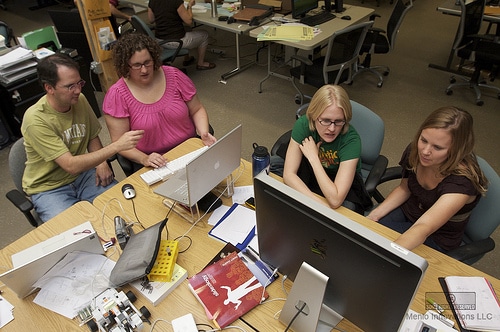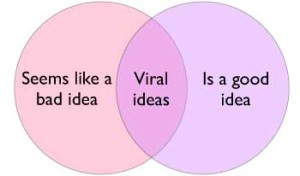
The developers who gathered in Snowbird, Utah in 2001 to write the original Agile Manifesto represented many different approaches to improving programming productivity: Scrum, Extreme Programming, Dynamic Systems Development Methodology (DSDM), Adaptive Software Development, Pragmatic Programming, etc. Other than rejecting the traditional waterfall methodology, they had little in common. It’s amazing, really, that they were able to agree on anything in 3 days, much less something as crisp and influential as the Agile Manifesto.
Since 2001, Scrum has emerged as the most commonly used Agile methodology, and many of us have applied Scrum to marketing. However, I’ve been asking myself if some of the alternative Agile methodologies can also be applied to marketing. The answer, I think, is yes. Over the next couple of weeks, I’d like to look at several of these alternatives, beginning with Pair Programming.
Pairs programming requires that two programmers sit in front of one computer – one drives, or enters code, the other observes, looking at the big picture, looking for mistakes or for unwarranted assumptions, commenting as the first programmer types. Every so often, they switch roles. The emphasis is on communication and quality.
There is some evidence that although pairs programming may take somewhat longer initially, it reduces the number of defects, and leads to long term productivity. Pairs programming has other benefits as well:
- It improves communication among the team
- It spreads knowledge. If one developer leaves, his partner has knowledge of the code
- It can be used to mentor less experienced programmers
How might this apply to marketing? Can we adopt something I’ll call Pairs Agile Marketing? Imagine a marketing team, divided up into pairs. Rather than having lots of group meetings (something us marketers seem to do a lot of), brainstorming particular marketing programs or deliverables, pairs of marketers divide up, one outlining or even creating marketing programs or materials, while the other looks over his or her shoulder, suggesting improvements, correcting mistakes and generally contributing to the finished product. After 30-60 minutes, they switch off.
The emphasis is on deliverables, not meetings. Quality control is built in. The pairs take a list of stories from the Sprint backlog, and complete them in a timely fashion. They could also use more of a Kanban style methodology to pull the next work item into their pair. Let’s call this Pairs Agile Marketing.
Can this work? I honestly don’t know. We’re going to try it at my office, and we’ll let you know. Has anyone else tried this? Is anyone else willing to try it and report the results?



Hello Jim,
Love the emphasis on deliverables. Since I have moved into marketing function, I have realized that having a draft deliverable in front of a customer makes our meetings so much more productive. With the tools nowadays, it is very easy to put together a draft deliverable pretty quickly, even one that looks pretty. I also find that people really debate on a small subset of a plan or deliverable. I have created a marketing backlog which I pull from and periodically confirm priorities as well as demo deliverables with customers.
Having paired marketing teams seems like an effective way to go about it. Haven’t tried it myself, but willing to give it a try. I think there could be certain types of deliverables that could be conducive to pair agile marketing, like creating a marketing campaign, drafting a news release, even editing a video or creating social media content.
And I am all for reducing group meetings as much as we can. A team of 2 or 3 folks can make far more progress than 5 or 8.
Samir
Good post Jim. I’d love to hear what your results are with this. Personally I think pairing creatives w/ writers would be interesting. While they typically work together on projects, it’s not in an ‘over-the-shoulder’ manner. And, while it’s not expected that a writer will become a designer, having real-time collaboration on the project could improve team dynamics like you mentioned.
Hi Travis – I work in pairs, or at most 3’s, as often as I can with my PM team, mktg and, almost all the time with, the creatives & web designers. It shortens the re-do cycle and the work product is better. We gain each others’ perspective too. No matter how hard you try to not do this, we all speak and understand our particular jargon. Working together provides the opportunity for clarity. Here’s to a prosperous 2014 and great pairings!
Software teams have found that ergonomics are exceedingly important to the practice of pairing. When pairing is introduced into an office space that is not prepared for the activity, the participants are often forced into uncomfortable physical spaces which lend to one person being dominant in the role and the other being a passive observer. It’s not uncommon for the activity to be received negatively simply because it’s physically uncomfortable to do. The pictures you included in the article show both obvious and subtle examples of this.
With much experimentation we have found the best setup for this to be dedicated pairing stations where each person has their own mouse, keyboard, and monitor which can each control the machine. On top of this, the best arrangement of this tend to be at a right angle to each other (think of each person sitting on adjacent sides of a square). This allows the pair to see each other easily and greatly increases the bandwidth of communication because it includes non-verbal cues in the pairing. It also allows for ample personal space.
Not all offices can be easily setup this way, but I would strongly encourage you to think about the ergonomics of pairing and optimize where you can. This can often make an extreme difference in the success of the activity, changing it from a dismal failure to something people love to do.
Thanks for the comment Justin. We’ll have to try out this kind of physical arrangement.
Hi Travis – I work in pairs, or at most 3’s, as often as I can with my PM team, mktg and, almost all the time with, the creatives & web designers. It shortens the re-do cycle and the work product is better. We gain each others’ perspective too. No matter how hard you try to not do this, we all speak and understand our particular jargon. Working together provides the opportunity for clarity. Here’s to a prosperous 2014 and great pairings!